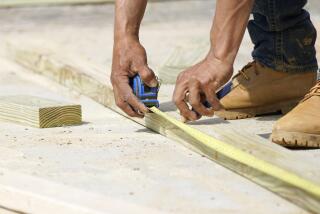Low Mortgage Rates Produce Homebodies
- Share via
Single-digit mortgage interest rates and stay-put homeowners have much in common.
In growing numbers, such enviable persons and families continue to live where they have--ever since the under-10% mortgage became an extinct financial species.
They represent a huge segment of the 64% homeownership figure among American families.
Before the year is out, they will have spent an unprecedented amount of dollars to fix up their homesteads--$76.7 billion.
Even though housing sales and starts thus far in 1985 have been encouragingly active, current interest rates still serve as a great damper against any major change or move to another home. They have opted to stay put and improve, and not move.
Cahners Economics, a Des Plaines, Ill.-based arm of Cahners Publishing Co., has the figures to show what is happening in the “improve-and-don’t-move” realm.
At the current pace of residential remodeling and repair, homeowners are spending 29% more money than they did in 1984. In the latter year, they spent 28.2% more than in 1983, indicating a very strong and almost unchanged rate.
The anticipated record of $76.7 billion includes costs of all materials used and contractor labor costs.
But James W. Haughey, director of economics for Cahners, also noted that more homeowners are taking repairs and remodeling into their own hands.
These more-handy and adventurous souls--rather than hiring contractors--are undertaking do-it-yourself projects at a rate which should account for $43 billion (of the $76.7 billion) this year, up 18% over the $36.3 billion they spent during 1984.
All of that is a result traceable, in Haughey’s mind, to the desire of so many homeowners to remain in their present dwellings which have comparatively low interest rates or where loans have long since been paid off.
“Their families have grown, and normally they’d move into larger homes. But the prospect of moving from an 8% mortgage rate . . . for example, to a 13% rate deters them. So, they find it’s more attractive to finance an addition to--or remodeling of--their present home at current rates rather than buying a new home,” Haughey said.
“Another factor that’s increasing home repair and modernization is the two-income family which has more disposable income to spend on modernizing homes. We feel, also, that the manufacturers of materials and tools are doing a much better job of designing and selling their products. Replacement parts are becoming a lot more ‘user friendly’ and manufacturers and retailers are making do-it-yourself projects much easier to do.”
Looking back over the evolvement of the popular do-it-yourself movement, we asked Haughey to tell us how much money was spent on such activities in the pre-10% interest era.
The total amount spent in 1977 was $31.2 billion. The interest rate was 8.87% then on a typical, conventional home mortgage. In 1978, the expenditure jumped to $37.1 billion while the rate had increased to 9.67%.
After that, the single-digit home loan became only a matter of great interest.
More to Read
Inside the business of entertainment
The Wide Shot brings you news, analysis and insights on everything from streaming wars to production — and what it all means for the future.
You may occasionally receive promotional content from the Los Angeles Times.










